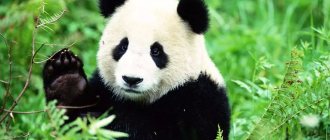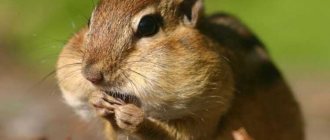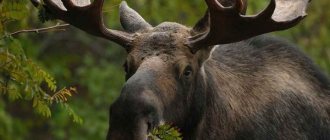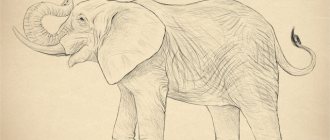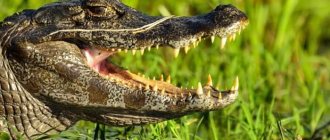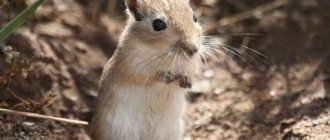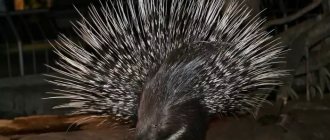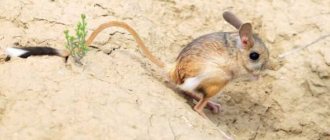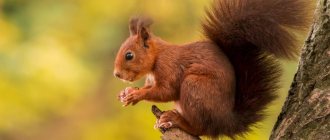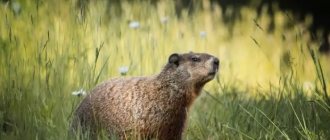Review author: “ZooVita”
The first association that arises with this unusual animal is its height. It can reach a height of up to 6 meters, about a third of which is its neck. This fact makes the giraffe one of the largest animals. At the same time, the weight reaches 1 ton.
Another feature, in addition to height, is the color of the coat. Each individual is unique due to its individual pattern of dark spots on a general light background. Below, the animal's body is lighter and has no spots.
In addition, color directly depends on the habitat. The spotted pattern plays an important role - it serves as an excellent camouflage. The spots look like shadows from tree crowns.
The head has ears and a pair of horns. In females they are thinner and with tassels, while in males the coat there is smoother.
The language deserves special attention. It reaches a length of up to half a meter, the organ itself is purple in color. Such a flexible and strong tongue helps the giraffe reach plants without being harmed by thorns.
The animal's strong legs are distinguished by their length. Thanks to this, the gallop speed increases to 55 km/h. However, giraffes prefer to walk slowly, moving their right legs in pairs, then their left ones.
Types of giraffes
In modern times, there are only four species and nine subspecies of these unique representatives of the fauna. They differ in the nature of their coat color and shades of spots. It is quite possible to distinguish one type of giraffe from another even from a photo.
Kinds:
- southern,
- Masai,
- mesh,
- northern.
Peacocks
The common (Indian) peacock lives in Sri Lanka, India, Pakistan, Bangladesh and Nepal.
The length of the peacock's tail is 0.5 m.
A characteristic feature of a male peacock is the strong development of the upper tail coverts, usually mixed with the tail feathers or tail feathers. There are two Asian species of peacocks: common and green.
Giraffe subspecies and their ranges
- West African, Chadian territory only;
- Maasai, Tanzania and southern Kenya;
- South African, territories of South Africa, Zimbabwe and Mozambique;
- reticulated, southern Somalia, northern Kenya;
- Kordofan, Central African Republic, western region of Sudan;
- Nubian, Western Ethiopia, eastern Sudan;
- Angolan, in Botswana and Namibia;
- Rothschild (Ugandan), Uganda;
- Thorneycroft, Zambia.
Pheasant Argus
The Argus pheasant is a bird from the pheasant family that lives in the jungles of Southeast Asia. One of the largest representatives of pheasants.
The length of the pheasant's tail is 76 cm.
The plumage of the argus is brown, the neck is reddish below, the head is blue, there is a crown of black hair-like feathers on the crown, and the legs are red. The male argus is decorated with a long tail; the length of his body with tail exceeds two meters. On the wings, males have very long secondary flight feathers with a pattern of large eyes. Young males acquire adult coloration only in the third year of life. The female is smaller and more modestly colored. She has a short tail and no ocellated pattern on her wings.
Behavior, lifestyle of a giraffe in the wild
The organs of vision, hearing and smell are also well developed, which helps to notice a threat in a timely manner. Add to this their height and now giraffes can see their relatives within a radius of a whole kilometer.
From early morning and throughout the day, the herbivore constantly chews cud. The animal falls into a half-asleep, although they continue to monitor the situation with the help of their ears. At night, they fall asleep, periodically getting up and laying down again on the cool ground. A couple of hours of sleep are enough for them per day, sometimes they can take a nap for 10 minutes.
A herd of giraffes is called a colony or family and consists of about 20 individuals. These are mainly young animals and females. Mothers are constantly close to their cubs; the rest can leave the group and return at any convenient time.
During the rainy season, the number of individuals in the herd increases to a maximum, and during drought it decreases to a minimum.
In search of food, giraffes can often cover an area of up to 100 km2. In addition, they have been spotted more than once in herds of antelope and zebra. This makes their movement safer.
The issue of hierarchy in the colonies has not yet been fully studied by specialists. However, it is still possible to highlight the advantage of older and stronger males over the rest in the group. In “families” of mothers and cubs, the eldest female becomes the main one.
Why are animals called that?
If you've ever wondered why mammals with giant necks are called "giraffes", then the answer is quite simple. In many languages, the name is constructed in comparison with a camel, for example, translated from Latin it means “camel-panther”. The name came to the Russian language from the French language - it is a borrowed word giraffe. The French named the animal this way after meeting a female, Zarafa, who arrived from Egypt, who subsequently lived in the Paris Zoo for eighteen years. Her nickname translated meant “elegant” or “fabulous.” In 2013, a cartoon called “Giraffe” appeared in France, which took this story as a basis.
Interesting facts about the tallest land animals on Earth:
- Giraffes don't yawn. Not a single scientist in the world has yet been able to see a giraffe performing this action, although they are monitored everywhere and 24 hours a day.
- The heart of a mammal moves more than fifty liters of blood per minute, which is surprising, because they even eat less in volume in a whole day. The heart muscle itself weighs up to 12 kg, and the pressure inside it can exceed human pressure three times.
- One giraffe somewhere in a zoo happily ate raw onions, after which enthusiasts tried to do the same thing several times with several individuals, and absolutely every one of them feasted on this product.
- We know that the neck of this animal is a third of its height, its tongue is half a meter and its height itself is about six, or maybe even more. But what is also surprising is the length of the tail, which on average varies from two to three meters.
- It can also be called strange that the mammal’s neck is still not long enough to drink water from a reservoir or snack on grass, so they kneel down and only then can they begin to replenish their water reserves.
- Unlike young representatives, who are hunted by leopards and hyenas, only the king of all animals, who is famous for his fearlessness, risks attacking adults.
- Although they feed for twelve hours, in fact, 6-7 kg of food is enough for them to live a normal life. They just don’t know what to do with themselves, so they eat almost all their free time.
Lifespan of giraffes
In the wild, these herbivores live no more than 25 years, but in zoos the figure reaches 30 or longer. But not everyone reaches such an “old” age.
The number is declining due to various factors: poachers, diseases, predators and nature itself. The latter mainly includes dry seasons and their attendant food shortages.
It is not just the size of the animal that provides some safety. As long as animals are in colonies of at least several individuals, predators will not risk attacking. This situation is especially good for young animals.
What does it look like
The main feature that distinguishes giraffes from all other animals is their long neck and, in principle, height. But, even taking into account such huge sizes, the giraffe’s spine does not differ from standard characteristics and has 7 cervical vertebrae, like any other mammals, as well as humans. The giraffe's color is filled with spots that form a special pattern that is never repeated in another individual. The head has horns covered with skin and fur, eyes located on the sides for good vision, and long eyelashes that some people find quite attractive.
Giraffe skeleton
Many people think that thin legs do not allow giraffes to move quickly, but this opinion is erroneous - the average speed of the animal is 60 km/h, and the jump height is more than one and a half meters. The running itself looks rather clumsy and cannot last for a long time, so basically the animals walk smoothly and only in case of danger do they go into a gallop.
The spots on the body are not only decoration, but also excellent camouflage in the environment - they imitate the play of light and shadow in the leaves of trees, due to which, even with its size, the animal can perfectly hide from predators.
Another feature of the appearance is the tongue, which has a dark blue, purple or even brown color, thanks to which long exposure to the sun does not cause harm. It is with the tongue that giraffes grab their food, so it has strong muscles and can stretch half a meter, which allows the animal to even clean its own ears.
Giraffe diet
Plant food is the main thing that giraffes eat. The diet of these animals consists of almost 50 species of plants. Depending on the rainy season or drought, they feed on both fresh grass and fallen dried leaves. Separately, it is worth highlighting acacias, which are found throughout the entire continent.
As a ruminant, the giraffe is constantly chewing something. As a result, meals can last about 12 hours, often longer. At the same time, according to scientists, they do not consume food without moderation. On average, one individual needs approximately 30 kg of food per day. During especially hungry periods, the volume decreases to 7 kg.
Water is not a basic necessity. Spotted animals get the right amount from their daily diet. However, one individual can drink up to 38 liters of liquid at a time.
Color, tongue size
One of the most interesting parts of the giraffe's body, besides the neck, is the tongue. The first thing you notice is its color: dark, sometimes even almost brown or purple. In addition, the giraffe's tongue is a very strong muscle, which makes it possible to tear branches from trees or their leaves located at great heights. Scientists have recorded that the length of a giraffe's tongue is 40-45 cm. This allows the long-necked animal to clean its own ears and drive annoying insects away from its face.
The animal feeds on any plants, some of which may have thorns, so the tongue has become hard and strong so that it does not suffer from various damage during eating.
Thanks to this unique feature of the structure of the tongue, the giraffe is saved from drought, which can often be observed where the animal lives. All lower leaves and grass are eaten by low-growing animals. Therefore, the giraffe has no choice but to eat leaves from the very tops of the trees, which no one has reached.
Range and habitat of giraffes
The only continent where giraffes live is Africa. They mainly prefer the dry forests of the South and West near the Sahara and savanna areas.
In the 20th century their habitat has narrowed significantly, their numbers have decreased. The reason for this was uncontrolled hunting and destruction of natural conditions. In the end, the largest number of animals are distributed in areas of national parks and reserves.
Security status
The giraffe population in some parts of their range was stable for a long time, but in others it was subject to extermination. Giraffes were hunted for their valuable meat, skin and tail. The population is still widespread in eastern and southern Africa, but has declined sharply in western Africa. In the Niger Republic, giraffe conservation has become a priority. In other places where large mammals have disappeared, giraffes have survived. This happened due to reduced competition with other animals.
Giraffe breeding
The mating season lasts from July to September. It is usually accompanied by fights between males, who become much more aggressive. Giraffes do not use their main, perhaps deadly, weapon - powerful attacks with their legs.
In fights, males try to pin their opponent against a tree trunk and then hit their head on the neck. It all ends when one of the opponents retreats. The winner drives off the second and raises his tail in triumph.
To understand whether the female is ready to mate, the males sniff them. Giraffes are polygamous by nature. Females are capable of reproduction by the age of 3-4 years, but they first have offspring at the age of 5 years.
Pregnancy lasts 14-15 months. Most often, one cub is born. Already an hour after birth, the little giraffe stands confidently on its feet, and after some time it walks calmly. The cub grazes grass within a few weeks, but continues to feed on mother’s milk for another year.
Character traits
Giraffes are not aggressive animals that, even in case of danger, would prefer to run away than to fight back. Their ability to communicate is also amazing - they can transmit information among themselves at a frequency of less than 20 Hz, which cannot be detected by human and, in some cases, even canine hearing.
Males often move in search of females who are interested in them: they can travel up to 20 km per day to find their love. The largest male often tries to take all the attention of the opposite sex to himself, not allowing smaller or younger ones to approach them. If the “alpha” comes across someone who wants to get a female on his way, he takes a fighting pose, stretching his neck vertically and straining his front legs, putting them towards his enemy. If the other male does not begin to retreat, then a duel begins, in which the main weapon is the neck. Mammals head-butt each other's bodies, intending to knock them down. The loser tries to retreat, but the dominant begins to chase for several meters, and then freezes in a victory pose with his tail raised up.
Enemies of giraffes in the wild
Great height is not an indicator that you will not be attacked. This is what happens with these herbivores - they become targets of predators in the African open spaces. These can be lions, leopards, hyenas or wild dogs. Young, inexperienced individuals, who are not as strong as the older generation, suffer more often.
Predators have to act carefully and thoughtfully - there is a possibility of dying from a powerful blow from the front hooves of the herbivore.
In addition to enemies, these animals also have “friends” in the form of small birds. They can often be seen on the backs of spotted herbivores. Their relationship is built, rather, on mutual assistance. Birds feed on insects, cleaning the back and neck of their “comrade” from parasites.
Why is it useful?
Nubian
For the indigenous tribes of Africa, giraffes have always been the subject of hunting, but getting them was not easy. Clothes made from animal skin among many African peoples indicated the high status of the owner. The sinews were used to make bows and ropes.
In nature, giraffes occupy their ecological niche as an intermediate link in the food chain. They are necessary to preserve predator populations on the continent.
Photos of all types of giraffes
Big flying possum
The giant flying possum lives on the east coast of Australia.
The length of the possum's tail reaches 55 cm.
Despite the fact that the great flying possum is the largest representative of marsupials capable of soaring, it is a small animal weighing 1-1.5 kg. Body length is 30-38 cm. A characteristic feature of this flyer is its large fluffy ears. The flying membrane extends from the knee to the elbow. The body of the animal is covered with silky and thick fur. Animals have different colors, the most common being black and brown shades.
Video
Author: Pavel Chaika, editor-in-chief of Poznavaika magazine
When writing the article, I tried to make it as interesting, useful and high-quality as possible. I would be grateful for any feedback and constructive criticism in the form of comments on the article. You can also write your wish/question/suggestion to my email [email protected] or Facebook, with respect, the author.
Author page
Long-eared jerboa
This small species of rodent is found in the desert areas of northwestern China. Their body length is 5 cm, but their tail is twice this length. The longest measurable tail on an individual was recorded at 15 cm, making this tiny rodent the number one mammal species with the longest tail in terms of how it relates to overall body length.
